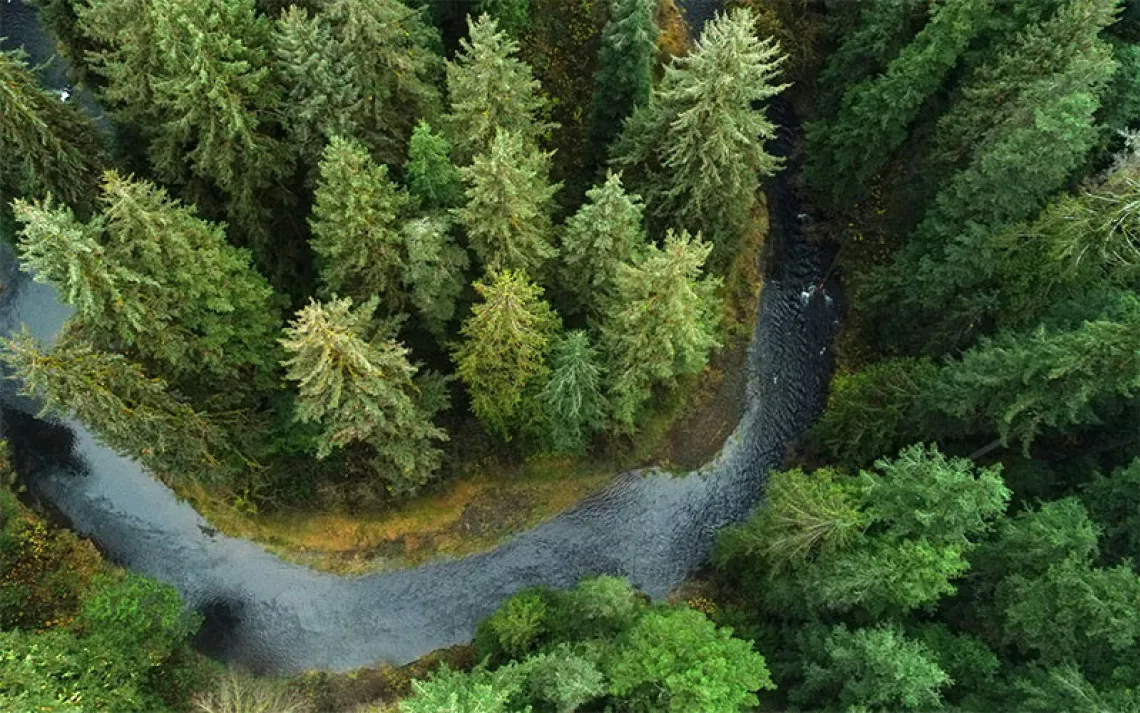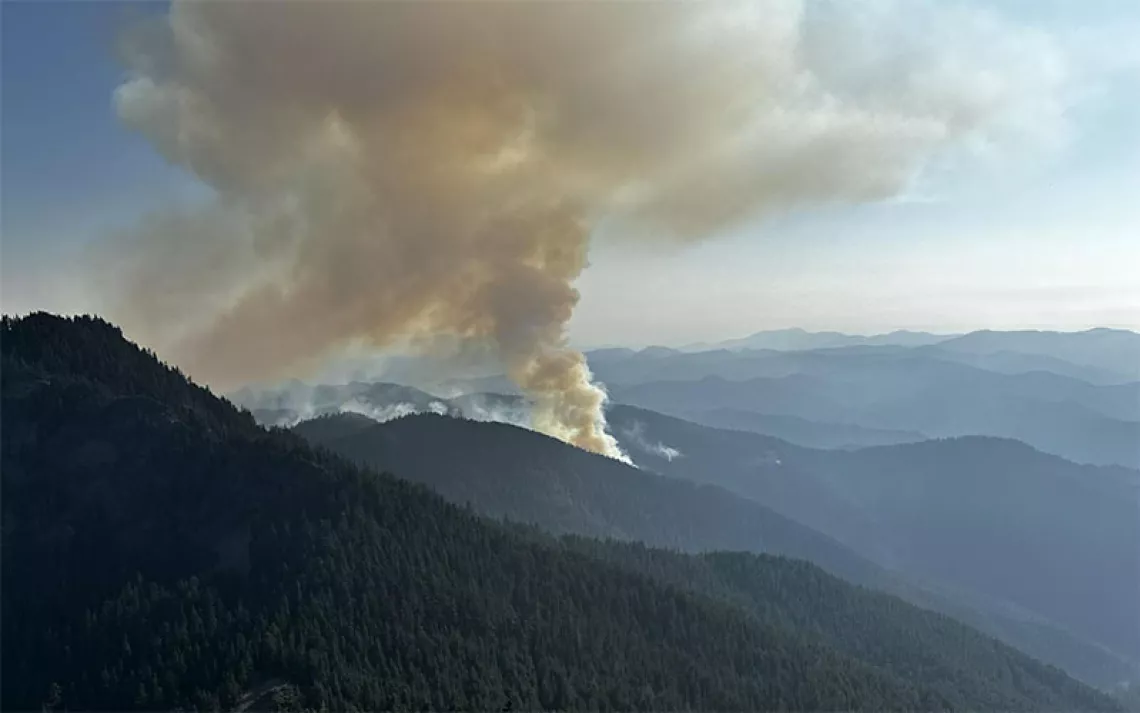We Can’t Save the Climate Without Also Saving the Trees
Scientists agree: Preserving forests is critical to combating climate change.

Photo by gorodenkoff/iStock
When many people think about global climate change, they tend to focus on the need to reduce greenhouse gases by transitioning away from fossil fuels like coal and oil and embracing renewable energy sources such as wind and solar. But preserving a stable climate will require more than just a change in our energy systems. Scientists and environmental advocates are beginning to pay more attention to another area that is critical to protecting the climate: forests and other natural ecosystems.
The most recent report from the International Panel on Climate Change was unequivocal: “Our planet’s future climate is inextricably tied to the future of its forests,” wrote the authors of the UN-sponsored study. On the eve of publication of the IPCC report, a group of international scientists released a statement saying that preserving forests is “just as urgent” as abandoning fossil fuels. “We must protect and maintain healthy forests to avoid dangerous climate change and to ensure the world’s forests continue to provide services critical for the well-being of the planet and ourselves,” the scientists declared.
Here in the United States, some 200 prominent individuals—mayors, celebrities, scientists, activists— have signed the Stand4Forests proclamation, which states: “Climate science shows that we cannot stop a climate catastrophe without scaling up the protection of forests around the world, including in the United States. Therefore, the U.S. must be a global leader in not only committing to phase out fossil fuel use but also in protecting our forests.”
“If we allow previously cut forests to grow to their full size, we could probably remove about 2 billion metric tons of carbon each year from the atmosphere,” says William Moomaw, a professor of international environmental policy at Tufts University and the coauthor of The Great American Stand: U.S. Forests and the Climate Emergency, which concludes that we could reduce annual carbon dioxide emissions by 75 percent in the next half century by using natural forests.
According to Moomaw, halting deforestation would avoid the release of about 3.1 billion metric tons of CO2 annually. Stopping the conversion of forest lands into agricultural fields and urban areas, he estimates, could remove another 1.3 billion metric tons of carbon from the atmosphere each year.
Climate stability is not the only reason Moomaw is a staunch forest defender. "Forests are most valuable left standing,” he says. “They provide clean water, medicines, food, recreation, scenery, pollination and regulation of floods, fires, insects, and disease. But tragically, short-sighted corporations have stripped the land bare. Humanity needs us to reverse this trend.”
The World Resources Institute recently found that tropical deforestation alone is releasing the greenhouse gas equivalent of almost 5 billion metric tons of carbon dioxide every year. If tropical deforestation were a country, it would be the third-largest greenhouse gas emitter in the world, after China and the United States. If tropical deforestation in places like Brazil and Indonesia continues much longer, it will virtually preclude the possibility of keeping average global temperatures from rising by more than 2˚C above preindustrial levels—much less the 1.5˚C that the new IPCC report warns is a dangerous threshold.
The heightened attention on forest conservation was evident at the Global Climate Action Summit, which occurred in San Francisco in September. Movie star and conservation champion Harrison Ford made an impassioned plea for the protection of forests and other natural ecosystems. Reminiscent of an Old Testament prophet with his gray hair and full gray beard, Harrison said that protecting and restoring forests is “the only feasible solution for absorbing carbon on a global scale.”
“The destruction of nature accounts for more global emissions than all the cars and trucks in the world,” Ford said from the event’s main stage. “We could put solar panels on every house; we could turn every car into an electric vehicle; but as long as Sumatra burns, we will have failed.… If we don’t stop the destruction of our natural world, nothing else will matter. Why? Because protecting and restoring forests, mangroves, wetlands—these huge dense carbon sinks—represent at least 30 percent or what needs to be done to avoid catastrophic warming.”
At the Global Climate Action Summit, conservation legend Jane Goodall announced the launch of the "30x30 Challenge"—a new campaign focusing on how forest conservation and restoration, “climate-smart” agriculture, and cutting food waste and overconsumption could get civilization almost a third of the way to the 2030 greenhouse gas reductions called for in the Paris climate agreement. As the 30x30 Challenge makes clear, changing global land-use practices is key to addressing climate change. Together, the agricultural, food, and forests sectors globally emit 12 billion metric tons of carbon-dioxide-equivalent greenhouse gases each year. That’s more than the emissions of all sectors except energy and amounts to 24 percent of total emissions. Land-use emissions exceed the emission of all the world’s cars, trucks, trains, planes, and ships, the 30x30 Challenge organizers say.
Under the leadership of former Peruvian minister of the environment Manuel Pulgar-Vidal, who chaired the 2014 climate change talks in Lima, more than 170 businesses and organizations have signed onto the 30x30 Challenge. Organizers believe the 30x30 target can be reached through a range of activities. These include reforesting land; adopting more sustainable forestry practices, such as longer periods between selective harvesting; and using controlled burns to prevent catastrophic wildfires. The 30x30 sponsors are also advocating for zero-deforestation supply chains, improvements in land tenure, the enforcement of national land-use laws, and improving agricultural soil health through cover cropping. The 30x30 Challenge also proposes methods for reducing food waste from crop to table, increasing recycling, and reducing overconsumption.
Some important actors are already making pledges to support the 30x30 vision. The Global Environment Facility—an international partnership of 183 countries and civil society groups—has pledged $500 million to support better land use and forest conservation. At the Global Climate Action Summit, Walmart and Unilever made new commitments to improve the sourcing of palm oil and paper without causing tropical deforestation. Through its Project Gigaton, Walmart is seeking to avoid a billion metric tons of GHG emissions from its “global value chain” by reducing deforestation associated with production of palm oil, timber, and beef. Unilever is working to get 148,000 acres of land in Malaysia certified by the Roundtable on Sustainable Palm Oil in the next seven years. Meanwhile, more than 75 major companies, including supermarket chain Tesco, and investors managing over $5.6 trillion in assets have agreed to stop deforestation and loss of native vegetation in Brazil’s threatened wooded grassland region known as the Cerrado. American food giant Sodexo already has programs in place to reduce the amount of waste generated from the millions of meals it serves daily.
Tackling 30 percent of greenhouse gas emissions through agriculture changes and forest preservation is a gargantuan challenge. And, at the same time, it’s entirely doable—if only because the option of failure is unthinkable. “Innovation is a function of constraints,” James Shaw, the New Zealand minister for climate change, said during the San Francisco summit. “When things really get constrained, that’s when you get creative. And the challenge of how to feed 10 or 11 billion people whilst producing next to no GHGs is the greatest constraint anyone could ever have thought of. So it’s the greatest driver of innovation.”
 The Magazine of The Sierra Club
The Magazine of The Sierra Club



